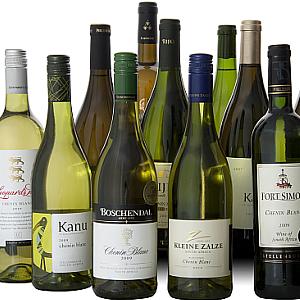Good-value
co-op Perdeberg has won Wine Magazine‘s 2011 Chenin Blanc Challenge with its uber-premium Rex
Equus 2008. The winners were announced yesterday at a lunch held at Overture restaurant on Hidden Valley wine farm. In a first for Wine
Magazine, a Top Dozen wines were named altogether and plans are afoot to offer
them as a mixed case to illustrate the quality and variety of this grape.
The Top Twelve
are as follows, all prices are from the farms:
Boschendal
2009 (R45)
Fort Simon
2009 (R60)
Graham Beck
Bowed Head 2009 (R95)
Jordan
Barrel Fermented 2009 (R71.50)
Kanu 2009
(R35)
Kanu KCB
2007 (R82)
Katbakkies
2008 (R70)
Leopard’s
Leap 2010 (R34.99)
Kleine Zalze
Cellar Selection Bush Vines 2010 (R33)
Perdeberg
Rex Equus 2008 (R180)
Rijk’s
Private Cellar Reserve 2007 (R160)
Simonsig
Avec Chene 2009 (R127)
The Best
Value wine to emerge from the Challenge was the 4-Star Douglas Green 2010,
selling at R31.50 – a wine which could easily have been joined by three others,
all under R35.
Chenin Blanc
is proving to be something of a marketing conundrum at the moment. South Africa
has some of the oldest and finest vineyards in the world and has continually triumphed in international competitions, regularly beating wines from the home of Chenin
– the Loire Valley in France.
Yet sales
still leave plenty of room for improvement, with many customers citing
‘uncertainty as to style’ being the main reason for not choosing a Chenin and sticking
to a Sauvignon instead. Because Chenin is such a versatile grape and can make a
range of styles from bone dry, through to semi-sweet and ending in luscious
dessert wines and can be wooded or unwooded and offer a vastly differing selection
of flavours, many people prefer to play safe and choose a wine where the style
is more guaranteed.
With this is
mind, the Chenin Blanc Association is proposing to classify the wines under
four headings:
Fresh and
fruity – unwooded
Rich and
ripe – unwooded
Rich and
ripe – wooded
Sweet wines
Jeff Grier,
deputy chairman of the Association, talks of a scale or diagram to put on the back label giving a more precise indication of exactly
what is in the bottle. The problem is, as always, getting everyone to agree on
the classifications/correct format/which style their wine falls into etc etc – discussions
which have so far stalled any development for almost a year.
According to
Jeff, teams of researchers are currently conducting interviews with consumers
to try and get some clarity on this issue and decide the way forward. The key
question seems to be how the wines will be classified, with opinion divided between
using set limits as to residual sugar and other standard markers (which are no
guarantees of the actual style of the wine, particularly at different stages of
maturation) and conducting tastings by a panel of experts (which is open to
abuse, particularly if marketing demands dictate a different classification
from that awarded).
Until something is agreed, it seems that South Africa could continue wasting its greatest vinous asset by self-serving disagreements and debates which augurs ill for the future. Because if sales don’t pick up, many of the older Chenin vineyards risk being dug up and replanted as they become commercially unviable, causing SA to lose its best chance of creating truly world class wines.
What do you
think? Do you drink Chenin Blanc and if so, do you only stick to the ones you
know? What would help you to choose a Chenin and how do you think it should be
indicated on the label? Tell us below.

